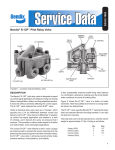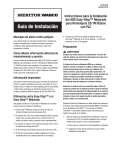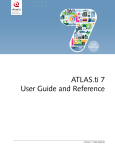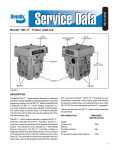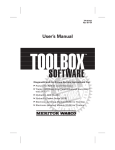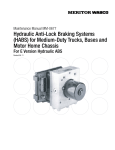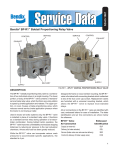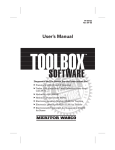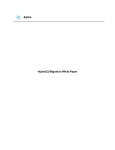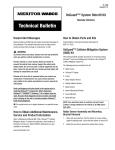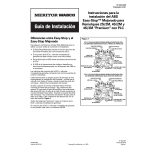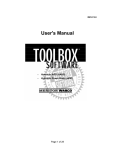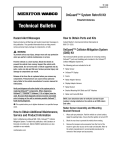Download TP-20214 - Meritor WABCO
Transcript
TP-20214 Revised 11-15 Installation Guide Hazard Alert Messages Read and observe all Warning and Caution hazard alert messages in this publication. They provide information that can help prevent serious personal injury, damage to components, or both. How to Obtain Additional Maintenance, Service and Product Information Refer to Maintenance Manual MM-0180, Enhanced Easy-Stop™ Trailer ABS with PLC; Maintenance Manual 33, Easy-Stop™ Trailer ABS; and Parts Book PB-96133, Enhanced Easy-Stop™ with PLC and Easy-Stop™ Trailer ABS. To obtain these publications, call the Meritor OnTrac™ Customer Call Center at 866-OnTrac1 (668-7221), or visit our website at meritorwabco.com. Important Information Use only genuine Meritor WABCO components. Other manufacturers’ parts are not designed for use with a Meritor WABCO ABS system and may not function correctly. Meritor WABCO recommends that a control line filter, part number 432-500-005-0, be installed on the air system’s control line, upstream of the ABS ECU/valve assembly. Differences Between Easy-Stop™ and Enhanced Easy-Stop™ There are some changes to Enhanced Easy-Stop™ that you need to be aware of before you begin the installation. 앫 Enhanced Easy-Stop™ includes Power Line Communication (PLC) function. 앫 The ECU/dual modulator valve assembly must be mounted as one unit. 앫 The LED on top of the ECU has been eliminated. 앫 The blink code tool LED does not operate simultaneously with the ABS lamp on the trailer. Enhanced Easy-Stop™ Trailer ABS 2S/2M, 4S/2M and 4S/3M Premium with PLC Installation Instructions Revised 1TP-20214 Technical 11-15 Bulletin 앫 For Enhanced Easy-Stop™ 4S/3M lift axle installations, you must use TOOLBOX™ Software, version 4.6 or higher, to enable the lift axle function. It is not automatically enabled. Refer to Enabling the Lift Axle Function (4S/3M Installations) in the Appendix for instructions. For 4S/2M lift axle installations, the lift axle function is automatically enabled. The valve portion of the ECU/dual modulator valve assembly contains two separate modulator valves that share common control and exhaust ports. Each valve has three delivery ports. Therefore, the mounting orientation — whether the valve is facing the front or the rear of the trailer — determines sensor hookup. If this assembly is mounted facing forward — toward the front of the trailer — the YE sensor connections go to the curbside and the BU sensor connections go to the roadside. If this assembly is mounted facing the rear, the YE sensor connections go to the roadside, and the BU sensor connections go to the curbside. Figure 1. All premium systems use the same ECU/dual modulator valve assembly. The ECU/dual modulator assembly cannot be used as a 2S/1M system. Figure 1 ECU/DUAL MODULATOR VALVE MOUNTED WITH SENSORS FACING FRONT OF TRAILER CURBSIDE YE2 CURBSIDE YE1 ROADSIDE BU1 ROADSIDE BU2 Park the vehicle on a level surface. Block the wheels to prevent the vehicle from moving. Support the vehicle with safety stands. Do not work under a vehicle supported only by jacks. Jacks can slip and fall over. Serious personal injury and damage to components can result. 1. SUPPLY PORT CONTROL PORT 앫 Look for crushed or bent connectors. PLUG ALL UNUSED PORTS DELIVERY CURBSIDE EXHAUST PORT ROADSIDE YE1 ROADSIDE YE2 SUPPLY PORT CURBSIDE BU1 CURBSIDE BU2 CONTROL PORT PLUG ALL UNUSED PORTS 앫 Do not install a damaged ECU/dual modulator valve assembly. Notify your supervisor, or contact Meritor WABCO if there is any apparent damage. 2. Have the following installation material available. * ECU/dual modulator valve assembly * ABS relay valve and relay valve extension cable with bayonet connector (3M systems) * Power cable or power/diagnostic cable * Sensor extension cables (two pieces for 2S systems, four pieces for 4S systems) * Sensors (two or four) for non-ABS prepped axles * ABS Indicator Label (TP-95172) DELIVERY ROADSIDE EXHAUST PORT DELIVERY CURBSIDE 4003566a Figure 1 5/8-inch O.D. nylon tubing for supply (frame mount) Pipe plug (3/4-inch NPTF) Schedule 80 hex pipe nipple (3/4-inch NPTF) for air tank mounts or two Grade 8 bolts (3/8-inch) and prevailing torque nuts for frame mounts Preparation SAE-standard, DOT-approved thread sealant WARNING To prevent serious eye injury, always wear safe eye protection when you perform vehicle maintenance or service. The Anti-lock Braking System (ABS) is an electrical system. When you work on the ABS, take the same precautions that you must take with any electrical system to avoid serious personal injury. As with any electrical system, the danger of electrical shock or sparks exists that can ignite flammable substances. You must always disconnect the battery ground cable before working on the electrical system. TP-20214 Revised 11-15 Page 2 앫 Verify that the retainer clips have not been bent or otherwise damaged. DELIVERY ROADSIDE ECU/DUAL MODULATOR VALVE MOUNTED WITH SENSORS FACING REAR OF TRAILER Before beginning the installation procedure, inspect the ECU/ dual modulator valve assembly for damage that may have occurred during shipping or storage. To ensure correct lamp operation, use an incandescent-type DOT-approved lamp, or an LED with integral load resistor. * Meritor WABCO components End of line testing must be done after all installations. Meritor WABCO recommends using TOOLBOX™ Software to perform this testing. If you do not have TOOLBOX™ Software, this bulletin also includes instructions for testing without the software. Copyright Meritor, Inc., 2015 (16579) Printed in USA Installation 1. I. Install the ECU/dual modulator valve assembly. Meritor WABCO does not recommend the use of a vise when installing the hex nipple. Use of a vise may cause overclamping. Overclamping may damage the internal components of the ECU/dual modulator valve assembly. The assembly may be mounted on the air tank or on the cross member of the vehicle. Tank-Mounted 2. Use a 3/4-inch NPTF pipe plug to plug the unused supply port. Apply SAE-standard, DOT-approved Teflon tape or paste-type thread sealant to all pipe threads beyond the first two threads. Pipes with pre-applied thread sealant may also be used. 3. Rotate and tighten the ECU/dual modulator valve assembly until the exhaust port faces DOWN and the connection is secure. Use a torque wrench or ratchet with an extension at the 3/4-inch pipe plug installed on the front supply port. Refer to Figure 2. Figure 2 ECU/DUAL MODULATOR VALVE MOUNTED WITH SENSORS FACING FRONT OF TRAILER (TANK-MOUNTED) Use a 3/4-inch NPTF Schedule 80 hex nipple to attach the ECU/dual modulator valve assembly to a reinforced air tank. Do not overtighten. CURBSIDE YE2 Mounted to Cross Member of Vehicle (Mounting Bracket Not Supplied) CURBSIDE YE1 Refer to Figure 3. ROADSIDE BU1 Figure 3 ECU/DUAL MODULATOR VALVE MOUNTED TO A CROSS MEMBER OF THE VEHICLE WITH SENSORS FACING FRONT OF TRAILER ROADSIDE BU2 Exhaust port must face DOWN. ECU/DUAL MODULATOR VALVE MOUNTED WITH SENSORS FACING REAR OF TRAILER PLUG ALL UNUSED PORTS ROADSIDE BU2 CURBSIDE BU2 CURBSIDE BU1 ROADSIDE YE1 ROADSIDE YE2 PLUG UNUSED PORT Exhaust port must face DOWN. ROADSIDE BU1 CURBSIDE CURBSIDE YE2 YE1 FRONT OF TRAILER ECU/DUAL MODULATOR VALVE MOUNTED WITH SENSORS FACING REAR OF TRAILER Exhaust port must face DOWN. ROADSIDE YE2 PLUG ALL UNUSED PORTS 4003548a ROADSIDE YE1 Figure 2 CURBSIDE BU1 WARNING You must use a Schedule 80 hex nipple (3/4-inch NPTF) to mount the ECU/dual modulator valve assembly securely to the air tank to avoid possible serious personal injury and damage to the component. (16579) Printed in USA CURBSIDE BU2 FRONT OF TRAILER 4005403b Figure 3 Copyright Meritor, Inc., 2015 TP-20214 Revised 11-15 Page 3 When mounting the ECU/dual modulator valve assembly to the trailer cross member, refer to SAE specification J447, Prevention of Corrosion of Motor Vehicle Body and Chassis Components. Follow all recommendations and procedures. Your supervisor should have a copy of this specification. 1. Use a 3/4-inch NPTF pipe plug to plug the unused supply port. Apply SAE-standard, DOT-approved Teflon tape or paste-type thread sealant to all pipe threads beyond the first two threads. Pipes with pre-applied thread sealant may also be used. 3. Rotate and tighten the relay valve assembly until the exhaust port faces down and the connection is secure. Use a torque wrench or ratchet with an extension at the 3/4-inch pipe plug installed on the front supply port. Figure 4. Install a 3/4-inch NPTF fitting in the supply port. Use a 3/4-inch NPTF pipe plug to plug the unused supply port (Port 1). Apply SAE-standard, DOT-approved Teflon tape or paste-type thread sealant to all pipe plugs beyond the first two threads. Pipes with pre-applied thread sealant may also be used. 2. 2. Figure 4 PLUG UNUSED PORTS Locate a position for mounting the assembly to the vehicle cross member midway between the side rails, close to the brake chambers the valve serves. Exhaust port must face DOWN. 앫 Drill two 3/8-inch mounting holes. The distance between the two holes (O.D.) must be 6.06-inches (154 mm) and mount directly to the cross member. CONTROL PORT 4 SUPPLY PORT 1 OR ABS EXTERNAL MODULATOR VALVE 앫 Build a mounting bracket with two 3/8-inch mounting holes spaced 6.06-inches (154 mm O.D.) apart. CAUTION Place a thin barrier of plastic, mylar or similar material between the bracket and mounting surface. The barrier is necessary to inhibit corrosion, which can occur from contact between dissimilar metals. Galvanic corrosion can result in damage to the ECU/modulator assembly. 3. Place a thin barrier made of plastic, mylar or similar material between the bracket and mounting surface to inhibit corrosion. 4. Use two 3/8-inch Grade 8 bolts with prevailing torque nuts to attach the assembly. Tighten the bolts to 18 lb-ft (24 N폷m). @ 1002073d Figure 4 Mounted to Cross Member of Vehicle (Mounting Bracket Not Supplied) When mounting the relay valve assembly to the trailer cross member, refer to SAE specification J447, Prevention of Corrosion of Motor Vehicle Body and Chassis Components. Follow all recommendations and procedures. Your supervisor should have a copy of this specification. 1. 앫 Apply SAE-standard, DOT-approved Teflon tape or paste-type thread sealant to all pipe plugs beyond the first two threads. Pipes with pre-applied thread sealant may also be used. II. Attach the ABS external relay valve (4S/3M systems only). Tank-Mounted 2. WARNING You must use a Schedule 80 hex nipple (3/4-inch NPTF) to mount the ECU/dual modulator valve assembly securely to the air tank to avoid possible serious personal injury and damage to the component. 1. Use a 3/4-inch NPTF Schedule 80 hex nipple to attach the relay valve assembly to a reinforced air tank. Do not overtighten. Meritor WABCO does not recommend the use of a vise when installing the hex nipple. Use of a vise may cause overclamping. Overclamping may damage the internal components of the ECU/dual modulator valve assembly. TP-20214 Revised 11-15 Page 4 Install a 3/4-inch NPTF fitting in the supply port. Use a 3/4-inch NPTF pipe plug to plug the unused supply port (Port 1). Install the valve with two locknuts and washers as required. Tighten the hex nuts to 18 lb-ft (24 N폷m). @ III. Connect the air lines. Before connecting the air lines, plumb the spring brake relay or emergency brake relay into the system as usual. 앫 If you are mounting on a bracket, connect the air supply line from the supply tank to the supply Port 1. Plug the unused port. 앫 Use 5/8-inch O.D. min. nylon tubing or heavy-walled Schedule 80 pipe nipple (3/4-inch NPTF) if you are mounting directly to the supply tank. Copyright Meritor, Inc., 2015 (16579) Printed in USA 1. 2. Connect the air delivery lines to the ECU/dual modulator valve assembly Port 2. For 4S/3M installations, connect the air delivery lines to Port 2 on the external relay valve (3/8-inch NPTF). 3. Connect the brake service (control) line to the ECU/dual modulator valve assembly Port 4 (1/4-inch NPTF). 4. For 4S/3M installations, perform the following procedures. Connect the air delivery lines to the appropriate brake chambers (3/8-inch NPT). Figure 5 and Figure 6. 앫 The valve portion of the ECU/dual modulator valve assembly contains two separate valves: one dedicated to roadside wheel ends, the other dedicated to curbside wheel ends. Each valve has three delivery ports. 앫 The external relay valve designated RED (RD) is an axle control valve. It controls brake chambers on one or two axles. It is important that delivery lines from Port 2 are plumbed as shown. Refer to Figure 13 through Figure 19. Figure 5 TYPICAL 2M INSTALLATION — VALVE MOUNTED WITH SENSORS FACING FRONT OF TRAILER 5. A. Connect the brake service (control) line to the ECU/dual modulator valve assembly Port 4 (1/4-inch NPTF) and ABS external relay valve control Port 4 (3/8-inch NPTF). B. Use an ABS relay valve connection cable to connect the ECU/dual modulator valve assembly with the ABS external relay valve. Plug any unused delivery ports. IV. Install the sensor extension cables (ABS-prepped axles). Instructions for installing sensors on non-ABS-prepped axles are included in the Appendix. Meritor WABCO recommends placing sensors on the axle that will provide the most braking performance. The suspension manufacturer can provide this information. 1. Visually inspect the tooth wheel and sensor to ensure no damage occurred during shipping. Perform any necessary repairs. 2. Connect the sensors and cables on the prepped axles to the sensor extension cables. Figure 7. Ensure that each connection is secure. SERVICE/CONTROL LINES SERVICE BRAKE SUPPLY AIR SPRING BRAKE AIR Figure 7 4003550a Figure 5 SENSOR EXTENSION CABLE Figure 6 TYPICAL 2M INSTALLATION — VALVE MOUNTED WITH SENSORS FACING REAR OF TRAILER SENSOR AND CABLE 4003567b Figure 7 3. SERVICE/CONTROL LINES SERVICE BRAKE SUPPLY AIR SPRING BRAKE AIR Route the sensor cable along the back side of the trailer axle to the ECU/dual modulator valve assembly. Route the cable with the brake hose. 4003551a Figure 6 (16579) Printed in USA Copyright Meritor, Inc., 2015 TP-20214 Revised 11-15 Page 5 Do not overtighten the tie wraps on a cable. Overtightening can damage the cable. Do not tie wrap the molded sensor plug. The sensor extension cable must follow the brake hose to the ECU/dual modulator valve assembly to allow for axle jounce and rebound. 4. Secure the cables every eight inches (203 mm) with tie wraps or cable clips. 5. Push the sensor retainer clip on the ECU/dual modulator valve assembly UP. 6. Remove the protective caps from YE2 and YE1 sensor connectors. 7. — Connect roadside sensor at YE1. 앫 4S/2M* — Connect curbside front sensor at BU1. — Connect curbside rear sensor at BU2. — Connect roadside front sensor at YE1. — Connect roadside rear sensor at YE2. 앫 4S/3M*— Sensor locations vary by type of installation. Refer to the diagrams for specific sensor locations. For Enhanced Easy-Stop™ 4S/3M lift axle installations, you must use TOOLBOX™ Software, version 4.6 or higher, to enable the lift axle function. It is not automatically enabled. Refer to Enabling the Lift Axle Function (4S/3M Installations) in the Appendix for instructions. Plug the sensor extension cables into the ECU/dual modulator valve assembly. To secure the connection, push the sensor retainer clip DOWN. Retainer clips must fit in the groove of the sensor connectors to ensure correct connection. ECU/Dual Modulator Valve Assembly Mounted with Sensors Facing Front of Trailer — Connect curbside sensor at BU1. — Connect curbside sensor at BU2. 앫 2S/2M — Connect roadside sensor at YE1. — Connect curbside sensor at YE1. — Connect roadside sensor at YE2. — Connect roadside sensor at BU1. * If the lift axle is sensed in 4S/2M and 4S/3M installations: Sensors YE2 and BU2 must always be used on the lift axle to avoid an unwanted ABS indicator lamp illumination. 앫 4S/2M* — Connect curbside front sensor at YE1. — Connect curbside rear sensor at YE2. 8. — Connect roadside front sensor at BU1. — Connect roadside rear sensor at BU2. 앫 4S/3M*— Sensor locations vary by type of installation. Refer to the diagrams on the following pages for specific sensor locations. Create a strain relief to protect the sensor extension connector terminals. Without this strain relief, normal trailer jounce and vibration will cause the terminals to spread and loosen. Use a tie wrap or clip to secure the cable to the brake air delivery hose as close to the fitting as possible. Figure 8. Figure 8 For Enhanced Easy-Stop™ 4S/3M lift axle installations, you must use TOOLBOX™ Software, version 4.6 or higher, to enable the lift axle function. It is not automatically enabled. Refer to Enabling the Lift Axle Function (4S/3M Installations) in the Appendix for instructions. — Connect curbside sensor at YE1. — Connect curbside sensor at YE2. — Connect roadside sensor at BU1. 4005457b — Connect roadside sensor at BU2. ECU/Dual Modulator Valve Assembly Mounted with Sensors Facing Rear of Trailer Figure 8 9. Bundle any excess cable in a “Z”-shaped loop. Figure 9. 앫 2S/2M — Connect curbside sensor at BU1. TP-20214 Revised 11-15 Page 6 Copyright Meritor, Inc., 2015 (16579) Printed in USA 4. Figure 9 BUNDLE EXCESS CABLE Push the hinged power/diagnostic connector retainer clip UP and remove the protective cap from the ECU/dual modulator valve assembly. Figure 11. Figure 11 CAP KEYED CABLE CONNECTOR 4003553a Figure 9 10. Secure excess cable in the sub-frame of the vehicle or along the air hoses as appropriate. Excess cable should not exceed two feet (0.61 meter). MATING TRAILER HARNESS CONNECTOR Various cable lengths are available. 4003569a V. Install the power and lamp or power and lamp/diagnostic cable. 1. Identify the type of cable to be installed. Figure 10. Figure 11 5. Plug the power 8-pin connector on the power or power/ diagnostic cable into the ECU/dual modulator valve assembly. 6. Pull the hinged power/diagnostic connector retainer clip on the ECU/dual modulator valve assembly DOWN to secure the connection. 7. If you are installing the power cable only, go to Step 9. 8. If you are installing the power/diagnostic “Y” cable: 앫 ABS trailer industry-standard pigtail connector power cable 앫 Blunt-cut power cable (not shown) Figure 10 POWER CABLE POWER/DIAGNOSTIC CABLE A. Install the diagnostic cable bracket so that the diagnostic plug is accessible. The normal location is on the right front corner of the sub-frame, but will vary depending on the type of trailer. B. Route the diagnostic cable from the ECU/dual modulator valve assembly to the diagnostic cable bracket. C. Correctly secure the cable in the sub-frame to prevent cable damage. 4003568a Figure 10 2. For industry-standard pigtail connector power cables, route the cable from the harness connector to the ECU/dual modulator valve assembly and secure it to prevent damage. For blunt-cut power cables, route the cable from the ECU/dual modulator valve assembly to a junction box which interfaces with the seven-way connector at the front of the trailer. Leave enough slack in the cable to compensate for flexing of the trailer and sub-frame. 3. Bundle any excess cable in a loop (bow tie) and secure it in the sub-frame of the trailer body to prevent cable damage. (16579) Printed in USA Leave enough slack in the cable to compensate for flexing of the trailer and sub-frame. D. 9. Bundle excess cable in a loop (bow tie) and secure the cable in the sub-frame. Figure 9. Install the ABS indicator lamp on the trailer. Refer to the vehicle specification sheet for the exact location of the indicator lamp. Use a DOT-approved lamp with ABS etched on the lens (available from major trailer parts suppliers). To ensure correct lamp operation, use an incandescent-type DOT-approved lamp or an LED with integral load resistor. Copyright Meritor, Inc., 2015 TP-20214 Revised 11-15 Page 7 If you are using the industry-standard connector cable and do not have access to the mating trailer harness, mask the open connector to protect it from paint or grease. 10. Connect the power. Use the industry-standard connector cable or a blunt-cut power cable. For industry-standard connector cables: Attach the power cable to the harness on the trailer. For an optional blunt-cut power cable: Wire the cable and ABS indicator lamp to the seven-way connector on the trailer according to the following diagram. Figure 12. Figure 12 GENERIC INPUT/OUTPUT (EXPANDED CAPABILITY) WHITE AND YELLOW 7 WAY YEL RED GRN BLUE (CONSTANT POWER) 3 7 BRN BLU RED (STOP LAMP) GREEN AND WHITE GROUND 2 6 BLK 1 5 WHT 4 OR 5 WIRE SCHEMATIC 4 8 WHITE (GROUND) TRAILER ABS INDICATOR LAMP ECU POWER CONNECTOR Junction box not shown. 4003570a Figure 12 Typical Easy-Stop™ Trailer ABS Installations Refer to Figure 13 through Figure 19 for typical Easy-Stop™ trailer ABS installations. Meritor WABCO recommends placing sensors on the axle that will provide the most braking performance. The suspension manufacturer can provide this information. TP-20214 Revised 11-15 Page 8 Copyright Meritor, Inc., 2015 (16579) Printed in USA Figure 13 2S/2M VALVE MOUNTED WITH SENSORS FACING FRONT OF TRAILER — SIDE-TO-SIDE CONTROL YE1 FRONT OF TRAILER YE2 YE1 BU1 NOTE: Spring brake lines not shown. BU2 BU1 2S/2M VALVE MOUNTED WITH SENSORS FACING REAR OF TRAILER — SIDE-TO-SIDE CONTROL BU1 FRONT OF TRAILER BU2 BU1 YE1 YE2 NOTE: Spring brake lines not shown. YE1 SERVICE/CONTROL LINES SENSOR CABLES SERVICE BRAKE SUPPLY AIR 4003554a Figure 13 Meritor WABCO recommends placing sensors on the axle that will provide the most braking performance. The suspension manufacturer can provide this information. (16579) Printed in USA Copyright Meritor, Inc., 2015 TP-20214 Revised 11-15 Page 9 Figure 14 4S/2M VALVE MOUNTED WITH SENSORS FACING FRONT OF TRAILER — SIDE-TO-SIDE CONTROL YE2 YE1 FRONT OF TRAILER YE2 Typical Tandem Axle Trailer YE1 BU1 BU2 BU1 NOTE: Spring brake lines not shown. BU2 4S/2M VALVE MOUNTED WITH SENSORS FACING REAR OF TRAILER — SIDE-TO-SIDE CONTROL BU1 BU2 Typical Tandem Axle Trailer BU2 BU1 FRONT OF TRAILER YE1 YE2 NOTE: Spring brake lines not shown. SERVICE/CONTROL LINES SENSOR CABLES SERVICE BRAKE SUPPLY AIR YE1 YE2 4003555a Figure 14 TP-20214 Revised 11-15 Page 10 Copyright Meritor, Inc., 2015 (16579) Printed in USA Meritor WABCO recommends placing sensors on the axle that will provide the most braking performance. The suspension manufacturer can provide this information. Figure 15 4S/2M TYPICAL TRI-AXLE — VALVE MOUNTED WITH SENSORS FACING FRONT OF TRAILER — SIDE-TO-SIDE CONTROL YE2 YE1 FRONT OF TRAILER YE2 NOTE: Spring brake lines not shown. YE1 BU1 BU2 BU1 BU2 4S/2M TYPICAL TRI-AXLE — VALVE MOUNTED WITH SENSORS FACING REAR OF TRAILER — SIDE-TO-SIDE CONTROL BU2 BU1 FRONT OF TRAILER NOTE: Spring brake lines not shown. BU2 BU1 YE1 YE2 YE1 SERVICE/CONTROL LINES SENSOR CABLES SERVICE BRAKE SUPPLY AIR YE2 4003556a Figure 15 (16579) Printed in USA Copyright Meritor, Inc., 2015 TP-20214 Revised 11-15 Page 11 Meritor WABCO recommends placing sensors on the axle that will provide the most braking performance. The suspension manufacturer can provide this information. Figure 16 4S/2M TYPICAL AXLE CONTROL INSTALLATION — VALVE MOUNTED WITH SENSORS FACING FRONT OF TRAILER BU1 YE1 FRONT OF TRAILER YE2 YE1 NOTE: Spring brake lines not shown. BU1 BU2 BU2 YE2 4S/2M TYPICAL AXLE CONTROL INSTALLATION — VALVE MOUNTED WITH SENSORS FACING REAR OF TRAILER BU1 YE1 BU2 FRONT OF TRAILER NOTE: Spring brake lines not shown. BU1 YE1 YE2 SERVICE/CONTROL LINES SENSOR CABLES SERVICE BRAKE SUPPLY AIR BU2 YE2 4002773a Figure 16 TP-20214 Revised 11-15 Page 12 Copyright Meritor, Inc., 2015 (16579) Printed in USA Meritor WABCO recommends placing sensors on the axle that will provide the most braking performance. The suspension manufacturer can provide this information. NOTE: For Enhanced Easy-Stop™ 4S/3M lift axle installations, you must use TOOLBOX™ Software, version 4.6 or higher, to enable the lift axle function. It is not automatically enabled. Refer to Enabling the Lift Axle Function (4S/3M Installations) in the Appendix for instructions. Figure 17 4S/3M TYPICAL TRI-AXLE WITH FRONT LIFT — VALVE MOUNTED WITH SENSORS FACING FRONT OF TRAILER YE1 YE2 FRONT OF TRAILER YE2 YE1 BU1 BU2 BU2 BU1 NOTE: Spring brake lines not shown. 4S/3M TYPICAL TRI-AXLE WITH FRONT LIFT — VALVE MOUNTED WITH SENSORS FACING REAR OF TRAILER BU1 BU2 FRONT OF TRAILER SERVICE/CONTROL LINES SENSOR CABLES SERVICE BRAKE SUPPLY AIR BU1 YE1 YE2 NOTE: Spring brake lines not shown. YE2 BU2 YE1 4003557a Figure 17 (16579) Printed in USA Copyright Meritor, Inc., 2015 TP-20214 Revised 11-15 Page 13 Meritor WABCO recommends placing sensors on the axle that will provide the most braking performance. The suspension manufacturer can provide this information. Figure 18 4S/3M TYPICAL TRI-AXLE — VALVE MOUNTED WITH SENSORS FACING FRONT OF TRAILER YE1 YE2 FRONT OF TRAILER NOTE: Spring brake lines not shown. YE2 YE1 SERVICE/CONTROL LINES SENSOR CABLES SERVICE BRAKE SUPPLY AIR BU1 Typical Tandem Axle Trailer BU2 BU2 BU1 4S/3M TYPICAL TRI-AXLE — VALVE MOUNTED WITH SENSORS FACING REAR OF TRAILER BU1 BU2 FRONT OF TRAILER BU2 BU1 YE1 Typical Tandem Axle Trailer YE2 NOTE: Spring brake lines not shown. YE2 YE1 4003558a Figure 18 TP-20214 Revised 11-15 Page 14 Copyright Meritor, Inc., 2015 (16579) Printed in USA Meritor WABCO recommends placing sensors on the axle that will provide the most braking performance. The suspension manufacturer can provide this information. Figure 19 4S/3M TYPICAL FOUR AXLE PULL TRAILER — VALVE MOUNTED WITH SENSORS FACING FRONT OF TRAILER YE1 YE2 FRONT OF TRAILER NOTE: Spring brake lines not shown. YE2 SERVICE/CONTROL LINES YE1 SENSOR CABLES SERVICE BRAKE SUPPLY AIR BU1 BU2 BU2 BU1 4S/3M TYPICAL FOUR AXLE PULL TRAILER — VALVE MOUNTED WITH SENSORS FACING REAR OF TRAILER BU1 BU2 FRONT OF TRAILER BU2 BU1 NOTE: Spring brake lines not shown. YE1 YE2 YE2 YE1 4003559a Figure 19 (16579) Printed in USA Copyright Meritor, Inc., 2015 TP-20214 Revised 11-15 Page 15 End of Line Testing Figure 20 End of line testing is required on all Enhanced Easy-Stop™ installations. To run these tests, Meritor WABCO recommends you use TOOLBOX™ Software. TOOLBOX™ Software and general test procedures are included in this bulletin. If you are using a Pro-Link, refer to the operating manual for test instructions. Enhanced Easy-Stop™ 2S/2M, 4S/2M and 4S/3M Premium Installation — End of Line Testing Procedure with TOOLBOX™ Software If you are testing an installation that has a power only cable, temporarily install a Meritor WABCO combination power/diagnostics “Y” style cable. 1. Connect the diagnostic connector on the cable to the PC serial port/SAE diagnostic interface (J1587/J1708 to RS232 interface). 4003560a Refer to the Software Owner’s Manual, TP-99102, for instructions for running TOOLBOX™ Software. Figure 20 2. Display the Trailer ABS Main Screen. 3. Verify the power supply. NONE = No faults present, proceed with end of line test. 앫 Apply 12 volts DC to the blue wire (constant). Check the screen for the correct voltage (9.5 to 14 volts). Constant power voltage is displayed in the PRIMARY field. Figure 20. YES = Faults present, double-click on “YES” to bring up the fault information screen. 4. 앫 Apply 12 volts DC to the red wire (stoplight power). Check the screen for the correct voltage (9.5 to 14 volts). Stoplight power voltage is displayed in the SECONDARY field. Figure 20. Check the Faults field on the Main Screen. Use the information in the Repair Instructions field to perform the necessary repairs. Figure 21. Figure 21 The internal field is not applicable to this test. 4003561a Figure 21 End of Line Test with TOOLBOX™ Software Verify Correct Valve and Lamp Installation To verify valve and lamp installations with TOOLBOX™ Software: 1. TP-20214 Revised 11-15 Page 16 Apply 12 volts DC to the ABS. Copyright Meritor, Inc., 2015 (16579) Printed in USA 2. Apply air to the emergency line to fill the air tanks and release the spring brakes. 3. Apply air to the control line. 4. At the Trailer Main Screen, click on Component Test, then select Valves/Lamp to display the Valve Activation Screen. The Yellow valve indicator will be highlighted. Figure 22. 앫 If the ECU faces the FRONT of the trailer, the slack adjusters will move in and out as the ROADSIDE portion of the dual modulator valve cycles. If this does not happen, the air lines are not correctly connected. Perform the necessary repairs. 앫 If the ECU faces the REAR of the trailer, the slack adjusters will move in and out as the CURBSIDE portion of the dual modulator valve cycles. If this does not happen, the air lines are not correctly connected. Perform the necessary repairs. Figure 22 8. For 4S/3M installations: Repeat this test for the red valve. Red: The external relay valve designated RED (RD) is an axle control valve. It controls brake chambers on one or two axles. It is important that delivery lines from Port 2 are plumbed as shown on the installation drawings. The 4S/3M system is designed to be used with a variety of trailer configurations. 9. Click on the Test button to activate the ABS indicator lamp — this is the lamp that is mounted on the side of the trailer. The lamp will flash eight times, indicating lamp installation is OK. The Test Status box at the bottom of the menu will display the status of this test. Figure 22. 10. Click on Close to exit. 4003562b Sensor Orientation Test Figure 22 This test is not for use on 4S/3M installations. 5. Click on the Activate button. 6. Check for correct air line installation. To accomplish this, observe the slack adjusters. 앫 If the ECU faces the FRONT of the trailer, the slack adjusters will move in and out as the CURBSIDE portion of the dual modulator valve cycles. If this does not happen, the air lines are not correctly connected. Perform the necessary repairs. 앫 If the ECU faces the REAR of the trailer, the slack adjusters will move in and out as the ROADSIDE portion of the dual modulator valve cycles. If this does not happen, the air lines are not correctly connected. Perform the necessary repairs. The Test Status box at the bottom of the menu will display the status of this test. 7. For 4S/3M installations, use the standard Sensor Test. To run the standard test, select Sensor Test from the Components Test Menu. The sensor orientation test must be performed as part of the end of line testing procedure. Sensor Orientation Test Screen Before beginning this test, look at the ECU to see if the sensors face the front or rear of the trailer. TOOLBOX™ will ask for this information to start the test (Step 5). To perform the sensor orientation test: 1. Raise the sensed wheel ends off the ground. 2. Apply air to the emergency line to fill the air tanks and release the spring brakes so that the wheels can be rotated. 3. Apply 12 volts DC to the ABS. 4. At the Trailer Main Menu, click on Component Test, then select Sensor Orientation Test to display the Sensor Orientation Test screen. Figure 23. Repeat this test for the Blue valve. A. Repeat Steps 1-3. B. Select the Blue valve from the valve activation screen. C. Click on the Activate button to verify correct valve installation (Blue). D. Check for correct air line installation. To accomplish this, observe the slack adjusters. (16579) Printed in USA When the Sensor Orientation Test screen first appears, the Sensors Facing field will display the default —Front. This will occur regardless of the actual sensor orientation of the installation being tested. Copyright Meritor, Inc., 2015 TP-20214 Revised 11-15 Page 17 NOTE: 2S/2M installations use YE1 and BU1 locations. Figure 23 6. Click on Start to begin the test. Figure 25. Figure 25 4005458a Figure 23 5. Click on Front or Rear in the Sensors Facing field to select the mounting orientation of the ECU/dual modulator valve assembly. Figure 24. Refer to Figure 23 and Figure 24 for illustrations of the ECU mounted with sensors facing forward and rear. The correct mounting orientation must be selected prior to starting the test (Step 5). 4005459a Figure 25 7. Figure 24 Follow the screen prompts, starting with 1, to rotate each sensed wheel end at a rate of 1/2 revolution per second. This rate equals a wheel speed of approximately 4 mph (7 kph). As each sensed wheel is rotated, check the color of the sensor identification block on the screen for results. Sensor identification boxes are located in the bottom left portion of the Sensor Orientation Test screen. Figure 24. Green background: Correct sensor location. Spin the next sensed wheel as indicated by the screen prompt. Red background: Incorrect sensor location. If you get a red background, you must stop the test (click on stop), make the necessary corrections and repeat Steps 3 through 6. 8. To finish the Sensor Orientation Test, click on Stop, then on Close. 9. Verify there is sensor output. If there is no sensor output, verify that a tone ring has been installed and that the sensor is pushed all the way in against the tone ring. Perform the necessary repairs and repeat the test. If the problem persists, contact Meritor WABCO (800-535-5560). Sensor output appears in the Sensors field located in the bottom right portion of the Sensor Orientation Test screen. Figure 24. 4005514a Figure 24 TP-20214 Revised 11-15 Page 18 Copyright Meritor, Inc., 2015 (16579) Printed in USA 앫 4S/3M*— Sensor locations vary by type of installation. Refer to the diagrams for specific sensor locations. End of Line Testing without TOOLBOX™ Software For Enhanced Easy-Stop™ 4S/3M lift axle installations, you must use TOOLBOX™ Software, version 4.6 or higher, to enable the lift axle function. It is not automatically enabled. Refer to Enabling the Lift Axle Function (4S/3M Installations) in the Appendix for instructions. Sensor Installation 1. Look at the sensor connectors on the ECU/dual modulator valve assembly. Ensure that the connectors are routed to the correct wheel-end location, as follows: ECU/Dual Modulator Valve Assembly Mounted with Sensors Facing Front of Trailer — Connect curbside sensor at BU1. 앫 2S/2M — Connect curbside sensor at BU2. — Connect curbside sensor at YE1. — Connect roadside sensor at YE1. — Connect roadside sensor at BU1. — Connect roadside sensor at YE2. 앫 4S/2M* * If the lift axle is sensed in 4S/2M and 4S/3M installations: Sensors YE2 and BU2 must always be used on the lift axle to avoid an unwanted ABS indicator lamp illumination. — Connect curbside front sensor at YE1. — Connect curbside rear sensor at YE2. — Connect roadside front sensor at BU1. 2. — Connect roadside rear sensor at BU2. 앫 4S/3M*— Sensor locations vary by type of installation. Refer to the diagrams for specific sensor locations. For Enhanced Easy-Stop™ 4S/3M lift axle installations, you must use TOOLBOX™ Software, version 4.6 or higher, to enable the lift axle function. It is not automatically enabled. Refer to Enabling the Lift Axle Function (4S/3M Installations) in the Appendix for instructions. — Connect curbside sensor at YE1. — Connect curbside sensor at YE2. — Connect roadside sensor at BU1. — Connect roadside sensor at BU2. ECU/Dual Modulator Valve Assembly Mounted with Sensors Facing Rear of Trailer 앫 2S/2M If sensors are not correctly installed, perform the necessary repairs. Air Line Installation 1. Ensure that all unused air ports are plugged and that the exhaust port is facing DOWN. 2. Look at the air line installation to verify that all air lines are correctly installed. 앫 If the ECU/dual modulator valve assembly is mounted with the sensors facing the FRONT of the trailer, the air lines for the three delivery ports located under the YE sensor connectors must be routed to CURBSIDE; the air lines for the three delivery ports on the opposite side of the valve must be routed to roadside. Figure 26. 앫 If the ECU/dual modulator valve assembly is mounted with the sensors facing the REAR of the trailer, the air lines for the three delivery ports located under the YE sensor connectors must be routed to ROADSIDE; the air lines for the three delivery ports on the opposite side of the valve must be routed to curbside. Figure 27. — Connect curbside sensor at BU1. — Connect roadside sensor at YE1. 앫 4S/2M* — Connect curbside front sensor at BU1. — Connect curbside rear sensor at BU2. — Connect roadside front sensor at YE1. — Connect roadside rear sensor at YE2. (16579) Printed in USA Copyright Meritor, Inc., 2015 TP-20214 Revised 11-15 Page 19 3. Figure 26 ECU/DUAL MODULATOR VALVE MOUNTED WITH SENSORS FACING FRONT OF TRAILER CURBSIDE YE2 CURBSIDE ROADSIDE YE1 BU1 ROADSIDE BU2 If the ABS indicator lamp comes on and stays on, check the sensor installation. PLUG ALL UNUSED PORTS YE DELIVERY CURBSIDE If the indicator lamp comes on for three seconds then goes out, this indicates a correct installation. The end of line test is complete. BU DELIVERY ROADSIDE A. Remove the power from the ABS and raise the sensed wheels so they may be rotated. B. Apply emergency air to fill the air tanks and release the spring brakes so that the wheels may be rotated. C. Repeat Steps 1 and 2. D. Rotate each sensed wheel — one at a time — at a rate of 1/2 revolution per second. This rate equals a wheel speed of approximately 4 mph (7 kph). 4003564a The ABS indicator lamp should now go out and stay out indicating a correct installation. The end of line test is complete. Figure 26 Figure 27 ECU/DUAL MODULATOR VALVE MOUTED WITH SENSORS FACING REAR OF TRAILER ROADSIDE YE2 ROADSIDE CURBSIDE YE1 BU1 CURBSIDE BU2 4. If the ABS lamp does not go out, there is a sensor gap problem or hardware fault. Adjust the sensor and, if necessary, perform a fault code check. Sensor Gap Adjustment Push the sensor into its holder until it contacts the tooth wheel. At installation, there must be no gap between the sensor and the tooth wheel. PLUG ALL UNUSED PORTS YE DELIVERY ROADSIDE BU DELIVERY CURBSIDE 4003565a For 4S/3M installations: Repeat this test for the red valve. Red: The external relay valve designated RED (RD) is an axle control valve. It controls the brake chambers on one or two axles. It is important that delivery lines from Port 2 are plumbed as shown in Figure 17, Figure 18 and Figure 19. The 4S/3M system is designed to be used with a variety of trailer configurations. 4. If the air lines are not correctly routed, perform the necessary repairs. Perform End of Line Test 1. Apply 12 volts DC power to the ABS. 2. Listen for the ECU/dual modulator valve assembly to click four times (six times for a 4S/3M). TP-20214 Revised 11-15 Page 20 Perform any necessary repairs. Repeat the end of line test. If the trailer lamp still does not go out, a system fault exists. Perform a fault code check. Fault Code Check Figure 27 3. Measure the AC voltage output. The value should be 0.2 volt AC when the wheel is rotated at a rate of 1/2 revolution per second. Use constant power activation to perform the following fault code check. 1. Apply constant power to the ECU/dual modulator valve assembly for more than one, but less than five seconds. 2. Remove the power. 3. Reapply the power. 4. Check the trailer ABS indicator lamp on the side of the trailer. The fault code will be displayed three times. 5. Find the fault on the chart and perform the necessary repairs. 6. After performing the necessary repairs, repeat the end of line test. Copyright Meritor, Inc., 2015 (16579) Printed in USA Trailer Identification Blink Code Chart Blink Code Problem Area Action 3 Determine sensor location. Sensor BU1 Check sensor installation. Perform necessary repairs. 4 Sensor YE1 Determine sensor location. After ensuring the Enhanced Easy-Stop™ trailer ABS has been correctly installed, attach the ABS indicator label included with the ECU/single modulator valve assembly to the trailer. Generally, this will be applied near the ABS trailer indicator lamp. Figure 28. Refer to the vehicle specification sheet for the correct location. Figure 28 Check sensor installation. NOTICE: Perform necessary repairs. 5 Sensor BU2 If the ABS indicator lamp comes on and stays on when you apply the brakes to a moving vehicle, the trailer ABS is not working properly. The ABS must be serviced as soon as possible upon completion of your trip to ensure full anti-lock braking capability. Determine sensor location. Check sensor installation. Perform necessary repairs. 6 Sensor YE2 Determine sensor location. TP-95172 Rev. 4/98 Check sensor installation. 4005501a Perform necessary repairs. Figure 28 7 External ABS modulator valve Verify correct electrical installation. Check power supply. Perform necessary repairs. 9 Internal modulator failure, inlet valve #2 Verify correct installation. If code continues, contact Meritor WABCO for assistance. 10 Internal modulator failure, inlet valve #1 Verify correct installation. If code continues, contact Meritor WABCO for assistance. 11 Internal modulator Verify correct installation. If failure, outlet valve code continues, contact Meritor WABCO for assistance. 14 Power Supply Verify correct electrical installation. Check power supply. Perform necessary repairs. 15 ECU Failure Verify correct installation. If code continues, contact Meritor WABCO for assistance. NOTE: If this label is not included with the assembly, let your supervisor know. Labels are available from Meritor WABCO. Ask for part number TP-95172. For additional assistance, contact the Meritor OnTrac™ Customer Call Center at 866-668-7221. Parts List Part Number Description Detail 400 500 102 0 2S/2M ECU Assembly ECU Valve Assembly 400 500 103 0 2S/2M-4S/3M ECU Assembly ECU Valve Assembly 400 500 105 0 2S/2M-4S/3M ECU Assembly with InfoLink ECU Valve Assembly 899 759 815 4 Sensor Spring Clip 449 326 005 0 Power Cable 0.5 meter 449 326 047 0 Power Cable 4.7 meter 449 713 018 0 Sensor Extension Cable 1.8 meter 449 713 030 0 Sensor Extension Cable 3.0 meter 16 SAE J1708 Failure Internal failure, contact Meritor WABCO. 449 713 050 0 Sensor Extension Cable 5.0 meter 441 032 808 0 Wheel End Sensor 0.4 meter 17 SAE J2497 Failure Internal failure, contact Meritor WABCO. 441 032 809 0 Wheel End Sensor 1.0 meter 18 Generic I/O Failure 432 500 005 0 In-Line Air Filter 899 201 842 4 In-Line Air Filter Label Check power supply. TP-95172 ABS Warning Label Perform necessary repairs. A complete part listing can be found in Meritor WABCO Parts Book PB-96133 available at meritorwabco.com. (16579) Printed in USA Verify correct electrical installation. Copyright Meritor, Inc., 2015 TP-20214 Revised 11-15 Page 21 Appendix I Figure 30 Enabling the Lift Axle Function (4S/3M Installations) To enable the lift axle function, you will need a PC with TOOLBOX™ Software, version 4.6 or higher, installed. Refer to the TOOLBOX™ User’s manual for complete operating instructions. This manual is posted on our website at meritorwabco.com. 1. Display the Trailer ABS Main Screen. Click on Modify to display the pull down menu. Figure 29. Figure 29 4005428a Figure 30 3. To change the default status and activate the lift axle function, click on Change. The Lift Axle Status will change to Active. Figure 31. Figure 31 4005427a Figure 29 2. Click on Lift Axle. The default lift axle screen will appear and display the default lift axle status Not Active. Figure 30. 4005429a Figure 31 TP-20214 Revised 11-15 Page 22 4. Click on Close to close the screen. Exit TOOLBOX™. 5. Remove power from the vehicle; then reapply power. Copyright Meritor, Inc., 2015 (16579) Printed in USA 6. Follow Steps 2 and 3 to display the Lift Axle Status screen. Verify the lift axle status display indicates the lift axle function is active, as illustrated in Figure 31. 4. If the lift axle function does not indicate active status, verify TOOLBOX™ version 4.6 or higher is installed. If you continue to receive a not active status message, contact the Meritor OnTrac™ Customer Call Center at 866-OnTrac1 (668-7221) for assistance. 7. Route the sensor cable toward the brake chamber, over the brake spider or through the pre-stamped hole dedicated for ABS sensors. Route to the back side of the axle. Secure the cable to the axle between the brake spider and the suspension brackets. Continue to route the sensor cable behind the spring seats. Secure the cable to the axle one inch from the molded sensor plug. Figure 33. Do not overtighten tie wraps on a cable. Overtightening can damage the cable. Do not tie wrap the molded sensor plug. The sensor extension cable must follow the brake hose to the ECU/valve assembly to allow for axle jounce and rebound. Disconnect TOOLBOX™ from the vehicle and proceed with end of line testing as described in this bulletin. Appendix II Brake hose clips with a provision for the sensor extension cable are recommended as opposed to tie wraps. Meritor WABCO does not supply this part. Installing Sensors on Non-ABS-Prepped Axles Figure 33 Sensor locations vary due to suspension type. Meritor WABCO recommends placing the sensor on the axle that will provide the most braking performance. Contact your suspension manufacturer for further information. 1. 2. SENSOR CABLE Apply a mineral oil-based grease that contains molydisulfide to the sensor spring clip, the body of the sensor and the bore of the sensor block. The grease must be anti-corrosive and contain adhesive properties that will continuously endure temperatures from −40° to 300°F (−40° to 150°C). 3" (76 MM) 4003573a Push the spring clip into the sensor holder from the inboard side, until the spring clip tabs are against the sensor holder. Push the sensor into the spring clip as far as possible. Figure 33 5. Install the wheel hub carefully so that the tooth wheel pushes against the sensor as the wheel bearings are adjusted. There should be no gap between the sensor and the tooth wheel. 6. Test the sensor output voltage. Use a volt/ohm meter to check the output voltage of the sensors while rotating the wheel at approximately 1/2 revolution per second. Minimum output must be 0.2 volt AC. If minimum output is less than 0.2 volt AC, push the sensor toward the tooth wheel. Recheck the sensor output. Use Meritor WABCO spring clips to ensure a correct fit. 3. Push the spring clip into the sensor holder from the inboard side until the spring clip tabs are against the sensor holder. Push the sensor into the spring clip as far as possible. Figure 32. Figure 32 SPRING CLIP TAB SENSOR HOLDER Appendix III Cable Strain Relief Guidelines SENSOR SPRING CLIP 4003572a It is important that cabling follow good strain relief practices to ensure maximum performance and durability. Failure to provide adequate strain relief on the cables can result in future maintenance that is not covered under warranty. Figure 32 (16579) Printed in USA Copyright Meritor, Inc., 2015 TP-20214 Revised 11-15 Page 23 Strain relief is defined as a small amount of slack in the cable at the area of connection. This lack of cable tension allows for slight movement of the cable during times when components of the suspension and air system may be in motion. A small amount of slack also eases access to other system components. A taut cable can affect the lifespan of the cable. Cables without adequate strain relief can potentially stress a cable connection enough that moisture could intrude. Unnecessary wear at bend points can be the result of a cable under tension. Cable strain relief is a universal practice. It applies to all Meritor WABCO product lines from Anti-Lock Brake Systems (ABS) to Roll Stability Systems (RSS). Excess Cable Length In cases where the length of cable exceeds what is required, the excess must be bundled in an efficient manner. It should not be draped or wrapped around components or left unsecured. Any slack remaining in the cable once the connections are made can be gathered up in a Z-shaped loop. Do not coil the cable and pinch into a bowtie or dog-bone shape. All cable zip ties should be tightened in a manner only to the extent that the cable is held sufficiently in place. Fasten the excess cable to an area that is free of sharp edges and moving components. Strain Relief at the ECU — Bracket Mounting Meritor WABCO recommends that cable connections to a component, such as an ECU valve assembly, display a visible amount of slack in the cable up to the first tie or clip that secures the cable to the trailer structure or air line. This first anchor point should be a minimum 6-inches (152 mm) of cable length from the cable/component connection and maximum of 12-inches (305 mm). This applies to all sensor, power, valve and GIO cables. Regardless of whether zip ties or cable clips are used, cables should be secured at intervals not greater than 18-inches (457 mm) to avoid cable vibration. Ideally, cables should be affixed to the rigid structure of the trailer. A good rule of thumb is to have the bend of the cable, also known as bend radius, be greater than or equal to ten times the diameter of the cable. If the cable is 1/4-inch (6.35 mm) in diameter, then the bend should be a minimum of 2-1/2-inches (64 mm). Refer to Figure 34 for the ECU mounting of 2S/2M-4S/3M ABS. Meritor WABCO has many lengths of cables available so it is a best practice to obtain a length that best suits the requirements of the installation. Figure 34 Z = ZIP TIE R R Z Z D D R 욷 10 X D R 욷 10 X D Bend radius (R) equal to or greater than 10 times cable diameter (D). First fastener must be a minimum 6-inches (152 mm) and a maximum of 12-inches (305 mm) from connector. 4011414a ABS 2S/2M-4S/3M Figure 34 TP-20214 Revised 11-15 Page 24 Copyright Meritor, Inc., 2015 (16579) Printed in USA Strain Relief at the ECU — Tank Mounting It is necessary that cable connections to a component, such as an ECU valve assembly, display a visible amount of slack in the cable up to the first tie or clip that secures the cable to the trailer structure or air line. This first anchor point should be a minimum 6-inches (152 mm) of cable length from the cable/component connection and a maximum of 12-inches (305 mm). This applies to all sensor, power, valve and GIO cables. Regardless of whether zip ties or cable clips are used, cables should be secured at intervals not greater than 18-inches (457 mm) to avoid cable vibration. Ideally, cables should be affixed to the rigid structure of the trailer. However, structure is not always available on tank-mounted installations. In these cases, securing the cable may be accomplished by fastening the cable to nearby air lines. It is important to note that cables should be secured only to the extent that the cable is held sufficiently in place. Refer to Figure 35 for 2S/2M-4S/3M ABS. Figure 35 4011414b CORRECT POWER AND GIO/MODULATOR CABLE STRAIN RELIEF FOR ABS 2S/2M-4S/3M Figure 35 Sensor Extension Cables at the ECU Figure 36 On valves that are tank mounted with no trailer structure nearby, or have remote-mounted cables, the sensor extension cables are attached to the air lines. Cable clips are preferred over zip ties. It is important to remember that cables should be fastened in a manner where the cable is secured enough where the cable will not move or chafe against what it is mounted to. A small amount of slack should be present to ensure that the cables do not become taut after installation or the servicing of components. Figure 36 illustrates the correct amount of slack in the sensor extension cables and correct attachment to the air delivery lines for ABS ECUs. SENSOR CABLE STRAIN RELIEF FOR ABS 2S/2M-4S/3M 4012337a Figure 36 (16579) Printed in USA Copyright Meritor, Inc., 2015 TP-20214 Revised 11-15 Page 25 Cable-to-Cable Connections It is important to ensure all cable-to-cable connections maintain good strain relief. Cable restraints must be placed between 2- and 4-inches (51-102 mm) from the cable connector to ensure correct strain relief. Regardless of whether zip ties or cable clips are used, cables should be secured at intervals not greater than 18-inches (457 mm) to avoid cable vibration. Refer to Figure 37 for air line attachment and Figure 38 for axle attachment. Common chassis ground can be verified by measuring the resistance between the J560 ground pin and the vehicle chassis (or frame) and confirming that the resistance is less than 10 Ohm (< 10 Ω). If this is not the case, the electrical contact at the common chassis ground point is not sufficient or not present. If a common chassis ground point is present, but not sufficient, ensure that there is no paint or debris inhibiting electrical contact at the ground point. If a common chassis ground point is not present, Meritor WABCO recommends adding one. NOTE: Do not add more than one common chassis ground point (connecting the J560 ground pin to the chassis) to avoid potential ground shifts within the vehicle electrical system. Figure 37 3" (76 MM) 3" (76 MM) ZIP TIES ON AIR LINES 4012336a Additionally, all standard trailer components, such as axles, should also be electrically connected to the common chassis ground. If the axles are not correctly grounded to the chassis, a ground strap electrically connecting the axle to the chassis may be added to ensure adequate protection from unwanted electrical noise. This can be verified by measuring the resistance between the vehicle chassis/frame and the other trailer component, then confirming that the resistance is less than 10 Ohm (< 10 Ω). Figure 37 For more details concerning correct vehicle grounding, reference SAE standard J1908. Figure 38 SENSOR CABLE Note during welding work on the trailer: 3" (76 MM) 앫 Disconnect power to the trailer. 앫 Disconnect all cable connections to devices and components and protect the plug-ins and connections from contamination and humidity. 앫 Always connect the grounding electrode directly with the metal next to the welding position when welding, to prevent magnetic fields and current flow via the cable or components. ZIP TIES ON AXLE 4011417a Figure 38 앫 Make sure that grounding connections are robust by removing paint or rust at the connection points. 앫 Prevent heat influences from the welding activity on devices and cabling when welding. Appendix IV Vehicle Electrical Grounding Guidelines Note during electrostatic painting the trailer frame or bogie: Ensure that the vehicle includes a correct common chassis ground point. A common chassis ground point connects the trailer frame/ chassis to the ground pin of the J560 seven-way connector and will protect the vehicle electrical system from unwanted electrical noise. 앫 Disconnect all cable connections to devices and components and protect the plug-ins and connections from contamination and humidity. Meritor WABCO Vehicle Control Systems 2135 West Maple Road Troy, MI 48084-7121 USA 866-OnTrac1 (668-7221) meritorwabco.com Information contained in this publication was in effect at the time the publication was approved for printing and is subject to change without notice or liability. Meritor WABCO reserves the right to revise the information presented or to discontinue the production of parts described at any time. Copyright 2015 Meritor, Inc. All Rights Reserved Printed in USA TP-20214 Revised 11-15 (16579)


























